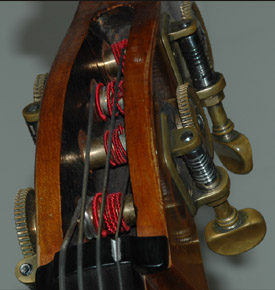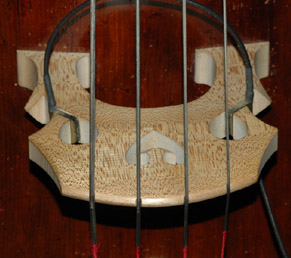The Double Bass
The double bass, also called bass Viol or contrabass, is the largest and lowest-pitched member of the orchestral string section. The standard double bass has four strings and a range from E just over an octave below the bass staff, upwards for nearly three octaves, although some instruments may have five strings in order to extend the range downward. The strings are tuned a fourth apart at E1(41.2 Hz), A1, D2, G2(98 Hz). For the double bass, the string tensions of the four strings are essentially equal, implying that the mass per unit length of the strings must be adjusted close to 9/16 ratios for successive strings. This is to achieve the musical fourth 4/3 pitch intervals since the string frequency is proportional to the inverse square root of the mass per unit length. Tables of string tension show tensions in the range 60 to 80 lbs for different compositions and manufacturers, but in all cases the tensions for the four strings are about the same. This is in contrast to the other members of the classical string family for which the tensions in the lowest pitch strings are significantly higher.
String instruments characteristically produce a fundamental resonance plus all the string harmonics.

 |
Because of the string mass and stiffness, a geared arrangement is used to adjust the string tension. |
The large bridge on the bass instrument transfers a component of the string vibration to the top plate of the instrument. This bridge is fitted with piezoelectric pickups on the bridge to produce an electrical output that can be amplified. |
 |
A good description of the interaction of the bow with the string on the bass may be found on the University of New South Wales site. The bow for the bass is typically made of black horsehair. The horsehair sticks to the string and pulls it to the side a certain distance and then releases it in a repetitive stick-slip pattern. For the low frequencies of the bass strings, the frequency of the stick-slip repetition can be equal to the frequency of the string, a condition associated with a full, rich tone for the instrument. This condition is referred to as the Helmholtz motion or "Helmholtz node" after Hermann von Helmholtz (1821-1894).
String instruments
Musical instruments
| HyperPhysics***** Sound | R Nave |